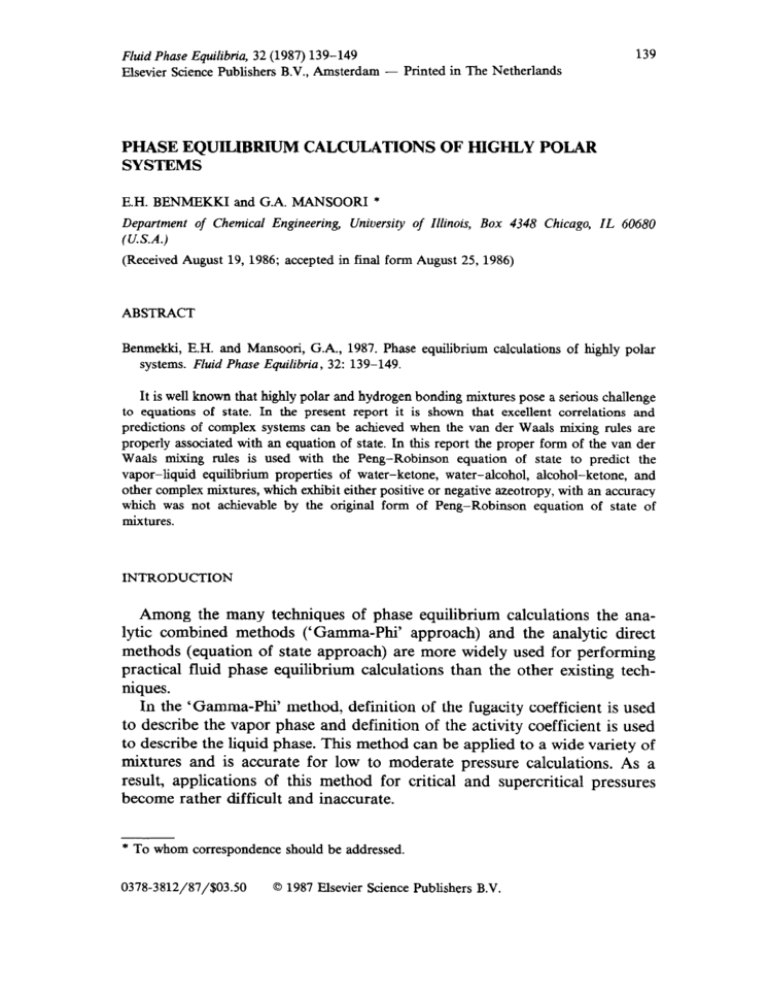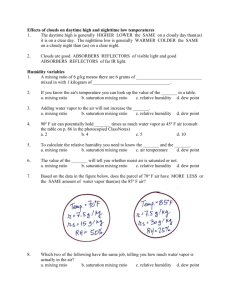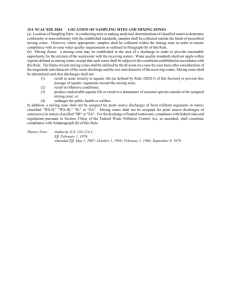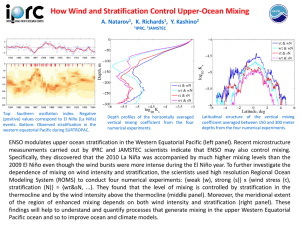Among the many techniques of phase equilibrium calculations the
advertisement

Fluid Phase Equilibria, 32 (1987) 139-149 Elsevier Science Publishers B.V., Amsterdam - PHASE EQUILIBRIUM SYSTEMS 139 Printed in The Netherlands CALCULATIONS E.H. BENMBKKI and GA. MANSOORI Department of Chemical Engineering, (U.S.A.) OF HIGHLY POLAR * University of Illinois, Box 4348 Chicago, IL 60680 (Received August 19, 1986; accepted in final form August 25,1986) ABSTRACT Benmekki, E.H. and Mansoori, G.A., 1987. Phase equilibrium systems. Fluid Phase Equilibria, 32: 139-149. calculations of highly polar It is well known that highly polar and hydrogen bonding mixtures pose a serious challenge to equations of state. In the present report it is shown that excellent correlations and predictions of complex systems can be achieved when the van der Waals mixing rules are properly associated with an equation of state. In this report the proper form of the van der Waals mixing rules is used with the Peng-Robinson equation of state to predict the vapor-liquid equilibrium properties of water-ketone, water-alcohol, alcohol-ketone, and other complex mixtures, which exhibit either positive or negative azeotropy, with au accuracy which was not achievable by the original form of Peng-Robinson equation of state of mixtures. INTRODUCTION Among the many techniques of phase equilibrium calculations the analytic combined methods (‘Gamma-Phi’ approach) and the analytic direct methods (equation of state approach) are more widely used for performing practical fluid phase equilibrium calculations than the other existing techniques. In the ‘Gamma-Phi’ method, definition of the fugacity coefficient is used to describe the vapor phase and definition of the activity coefficient is used to describe the liquid phase. This method can be applied to a wide variety of mixtures and is accurate for low to moderate pressure calculations. As a result, applications of this method for critical and supercritical pressures become rather difficult and inaccurate. * To whom correspondence 0378-3812/87/$03.50 should be addressed. 0 1987 Blsevier Science Publishers B.V. 140 In the equation of state approach, definition of the fugacity coefficient is used to describe both liquid and vapor phases through the application of a single equation of state. The major advantage of this technique is its applicability for the ranges of pressures including critical and supercritical pressures. However, phase equilibrium calculations by this method will be rather lengthy except for simple equations of state. Another problem with the use of the equation of state technique is the insufficiency of information about the exact form of the equation of state of mixtures and inaccuracy of the existing mixing rules for mixtures consisting of polar and hydrogen bonding components and components with large molecular size and shape differences. Soave and Cubic equations of state, such as the Redlich-Kwong, Peng-Robinson equations, have been shown to yield accurate predictions of hydrocarbon and non-polar fluid phase behavior. But a common deficiency of all such equations of state is their inability to provide acceptable predictions of phase behaviour of systems involving highly polar fluids. In a recent publication (Kwak and Mansoori, 1985) a new format for the formulation of the van der Waals mixing rules for cubic equations of state was presented. The new format was previously used for prediction of solubility of solids in supercritical fluids and fluid mixtures with success (Mansoori and Kwak, 1985). In the present report we apply this new concept of the van der Waals mixing rules to vapor-liquid equilibrium calculations of mixtures of highly polar fluids of practical interest. THE CONCEPT OF THE VAN DER WAALS MIXING RULES As an example the Peng-Robinson equation of state (Peng and Robinson, 1976; Robinson, et al., 1985) is chosen in this study to perform vapor-liquid equilibrium calculations. To apply the van der Waals mixing rules correctly in the Peng-Robinson equation of state, we must separate thermodynamic variables from constants of the equation of state. Thus, we can write the Peng-Robinson equation of state in the following form (Kwak and Mansoori, 1985) z=u- u-b c/RT + d - 2J( cd/RT) (u+b)+(b/u)(u-b) where c = a(TJ(1 + K)~ and d = CZ(T,)K~/RT, This new form indicates that this equation of state has three independent constants which are b, c and d. Parameters b and d are proportional to (molecular length )3 or (b a h and d a h),while parameter c is proportional 141 to (molecular length)3 - (molecular rules for c, b and d will be energy) or (c afh). Thus, the mixing n i b= d= (2) ~XiXjCij c= i j k ixixjbi, i j n n c (3) (4 zxixjdij i j The correct combining rules (Rowlinson and unlike interaction parameters b, c and d will be bij= (1 - b!13 + ” 2 lij)3 b?13 ” [ d,, = (1 - mij) ‘[ d;[3 :“;I 1 Swinton, 1982) for the 3 (5) (6) ci j = (1 - k, j) [ cii - cjj/b,, . b,] 1’2 biJ (7) In eqns. (5)-(7) parameters k,,, lij and mij are the binary interaction parameters that can be adjusted to provide the best fit to the experimental data. VAPOR-LIQUID EQUILIBRIUM CALCULATIONS When applying the analytic direct method for vapor-liquid equilibrium calculations, the success of the vapor-liquid equilibrium predictions depends on the accuracy of the equation of state and on the mixing rules that are used. The Marquart minimization procedure is used in the computation of the binary interaction parameters through the bubble pressure vapor-liquid equilibrium calculation method with the following objective function P(exp) Pbd -P(cal) 1 * i (8) where M is the’ number of experimental data considered, P(exp) is the experimental equilibrium pressure and P(ca1) is the calculated equilibrium pressure. 142 From the above equation expressed as AP/P the average deviation = (OF/M)“* in pressure can be (9) The vapor-liquid equilibrium calculation described above can be used for any kind of mixture so long as an equation of state, with proper mixing rules, is available for that mixture. In the present report we specifically concentrate on mixtures of highly polar fluids to demonstrate the versatility of the correct form of the van der Waals mixing rules, RESULTS AND DISCUSSION The binary systems chosen for this study are the ones for which cubic equations of state (specifically the Peng-Robinson equation of state), with their conventional mixing rules, have been incapable of properly predicting their phase behavior. The systems chosen for this study consist of water-ke- ACETONE (1) - WATER (2) ‘shoe T = 0.0 428.15U ’ 0.0 0.1 0.2 0.3 0.4 X(1) 0.5 0.6 0.7 0.6 0.9 0 * Y(1) Fig. 1. Equilibrium pressure-composition diagram for acetone-water. -, new mixing rules with the binary interaction parameters, k12, II2 and nr12, equal to zero; 0 and l, experimental data (Griswold and Wong, 1952). 143 tone, water-alcohol, alcohol-ketone and other complex mixtures, which exhibit either positive or negative azeotropy. The acetone-water system provides an interesting example of the influence of the mixing rules and combining rules on the vapor-liquid equilibrium calculations involving highly polar fluids. In Fig. 1 the solid line is the prediction by the Peng-Robinson equation of state with the new mixing rules and combining rules and with the binary interactiori parameters (kij, fij and mjj) equal to zero. It should be pointed out that no phase behavior is predicted with the use of the Peng-Robinson equation of state and its conventional mixing and combining rules when the interaction parameter tij is set equal to zero. The question may arise concerning the reason for replacing the geometric mean combining rule cij = ( ciicjjy2 (10) ACETONE (1) - WATER (2) Fig. 2. Vapor-liquid equilibrium composition diagram for acetone-water. -, new mixing rules with eqn. (7) as the combining rule; - - - - - -, new mixing rules with eqn. (10) as the combining rule; 0, experimental data (Griswold and Wong, 1952). ACETONE (1) - WATER (2) ACETONE (1) - WATER (2) 16 f = 423.15K (b) 0 0.0 0.1 0.2 0.8 0.4 X(l) 0.6 , Y(l) 0.0 0.7 0.8 0.0 145 ACETONE (1) - WATER (2) a5 90 Es 3 26 I n 20 16 1.0 0.1 0.2 I 0.6 0.4 X(1) 0.6 0.6 0.7 0.8 0.6 ,O I WV Fig. 3. Equilibrium pressure-composition diagram for acetone-water. - - - - - -, original mixing rules with a fitted parameter &.; -, new mixing rules with three fitted parameters I&, [IT and m12;0 and 0, experimentaldata (Griswoldand Wong,1952). with eqn. (7) as the cornbiting rule for parameter c. Of course, theoretically it is proved (Rowlinson and Swinton, 1982) that eqn. (7) is a more accurate combining rule than eqn. (10) for parameter c. However, to demonstrate the superiority of eqn. (7) over eqn. (lo), we use Fig. 2. In Fig. 2 the Y-X diagram corresponds to the same data as in the P-X diagram of Fig. 1. This figure illustrates the marked improvement which is gained by the introduction of the correct combining rule, eqn. (7), over the geometric mean combining rule, eqn. (lo), for parameter c of the Peng-Robinson equation of state. The solid line in Fig. 2 is the prediction with the new mixing rules and Eqn. (7) as the combining rule for c, while the dashed line represents the same equation of state and mixing rules but with eqn. (10) as the combining rule for c. In this figure, as in Fig. 1, the interaction parameters are set equal to zero. Figure 2 is also indicative of the fact that eqn. (10) falsely predicts phase splitting for the acetone-water system. The Peng-Robinson equation of state with its original mixing rules does not predict any phase equilibrium for these data when its interaction parameter, tij, is set equal to zero. 146 P-BUTANOL (1) - WATER (2) .O Fig. 4. Vapor-liquid equilibrium composition diagram for 2-butanol-water. - - - - - -, original mixing rules with a fitted parameter &; -, correct mixing rules with three fitted parameters k12, [I* and m12; l,experimental data (Chem. Data Ser., 1977). To demonstrate the superiority of the new mixing rules over the conventional mixing rules in predicting vapor-liquid equilibrium at different temperatures and pressures, we use Fig. 3a, b, c. According to this figure data correlation is greatly improved by the new mixing rules. Also it can be seen from this figure that the conventional mixing rules have a tendency towards false phase-splitting due to the unexpected shape of the bubble point curve. Figure 4 demonstrates that the correct van der Waals mixing rules properly predict a phase splitting of the 2-butanol-water system at 353.15 K and correlate the vapor-liquid equilibrium data more accuratly than the conventional mixing rules. The 1-propanol-water system is another example for which the correct van der Waals mixing rules outperform the classical mixing rules, as demonstrated in Fig. 5. A false phase-splitting is predicted by the classical mixing rules while an excellent correlation of the experimental data is obtained with the correct mixing rules. ,.- Nagata and 323.15 Hayashida (1970) Methyl acetate-chloroform - Chem. Data Ser. (1982) Carbon dioxide-methanol - Griswold and Wong (1952) Acetone-methanol - Chem. Data Ser. (1977) 2. Butanol-water - Chem. Data Ser. (1977) 1. Propanol-water .-- 298.15 313.15 373.15 423.15 333.15 353.15 333.15 363.15 373.15 423.15 473.15 Griswold and Wong (1952) Acetone-water Temperature (kelvin) Reference System _._- 0.60-0.76 8-59 6-80 3.5-4.0 12-14 0.18-0.31 0.45-0.75 0.19-0.31 0.91-1.10 l-4 5-12 16-30 Pressure range (bars) --. 0.1021 - 0.2606 -0.1648 - 0.0964 - 0.1858 0.0080 0.1377 0.1722 0.2307 0.0937 - 0.1605 - 0.1148 0.1042 0.0917 0.0716 0.0991 0.1083 0.1374 0.0944 0.1185 0.1260 -0.0508 0.0156 0.0074 0.1445 0.0373 0.0579 -0.0182 -0.0528 -0.0789 ml2 DP/P@) 0.5 1.4 3.1 1.1 0.7 1.6 2.4 2.3 0.3 1.7 0.8 0.8 -0.0419 _- 0.0426 0.0603 -0.0043 0.0082 - 0.2015 -0.1891 - 0.1224 - 0.1092 - 1.1993 - 0.1724 - 0.1410 2.8 6.2 5.0 2.4 2.1 8.1 8.5 6.0 5.8 15.0 10.9 8.5 DPP’C% 9 8 8 10 10 13 10 13 10 10 9 10 512 - 0.0893 - 0.1001 - 0.1023 I 12 k 12 - 0.2742 - 0.3627 - 0.4065 Original mixing rules M Correct mixing rules Binary interaction parameters Values of the binary interaction parameters and the corresponding average pressure deviation for the different mixing rules. TABLE 1 5 VPROPANOL (1) - WATER (2) Fig. 5. Vapor-liquid equilibrium composition diagram for 1-propanol-water. - - - - - -, original mixing rules with a fitted parameter &; -, correct mixing rules with three fitted parameters k,,, I,, and m,,; 0, experimental data (Chem. Data Ser., 1977). The values of the binary interaction parameters, as well as the corresponding average pressure deviations for all the mixtures considered in this study, are reported in Table 1. Overall it is demonstrated here that the statistical mechanically proper van der Waals mixing rules can improve prediction of highly polar mixture properties with the Peng-Robinson equation of state. This method is general and may be applied as well to other cubic equations of state. LIST OF SYMBOLS a, b, c, d equation of state parameters pressure gas constant temperature lJ molar volume z compressibility factor P R T 149 superscripts or subscripts critical property component identification i, j ij or 12 binary pair of components C i and j or 1 and 2 ACKNOWLEDGMENT This research is supported by The Chemical Sciences Division, office of Basic Energy Sciences of the U.S. Department of Energy, Grant No. DE-FGO2-84ER13229 REFERENCES Chemistry Data Series, 1977. D. Behrens and R. Eckerman (Editors), Vol. 1, Part 1. Chemistry Data Series, 1982. D. Behrens and R. Eckerman (Editors), Vol. VI. Griswold, J. and Wong, S.Y., 1952. Chem. Eng. Prog. Series, 48, No. 3: 18. Kwak, T.Y. and Mansoori, G.A., 1985. Chem. Eng. Sci. 41, No. 5: 1303. Mansoori, G.A. and Kwak, T.Y., 1985. Paper presented at 9th Symposium on Thermophysical Properties, University of Colorado, Boulder, CO, June 24-27, 1985. Nagata, I. and Hayashida, H., 1970. J. Chem. Eng. Jpn., 3: 161. Peng, D.Y. and Robinson, D.B., 1976. Ind. Eng. Chem. Fund., 15: 59. Robinson, D.B., Peng, D.Y. and Chung, S.Y.K., 1985. Paper presented at the Annual AIChE Meeting, San Francisco, CA. Rowlinson, J.S. and Swinton, F.L., 1982. Liquid and Liquid Mixtures. Butterworths, Wolbom, MA, 3rd. Edition.







